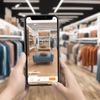In a landscape increasingly dominated by digitally-native consumers, new implementations of technologies like augmented reality in retail allow businesses to increase value and customer engagement significantly.
The statistics speak volumes about this and other AI-driven processes:
- 66% of consumers express an interest in using augmented reality for their purchasing decisions
- The number of people regularly using AR and VR is expected to reach 3.7 billion by 2028.
- AR can extend beyond customer interactions, playing a role in skills training, product design, and more.
Augmented reality, or AR, offers capabilities that will enhance both physical and digital interactions with customers and staff. Because of projected usage, it’s only a matter of time before AR features worth their salt become an expectation from most brands.
Throughout the following article, we will:
- Explain how augmented reality in retail works or is expected to work.
- The benefits of AR.
- Use cases of AR for retail.
What is Augmented Reality?
At its core, augmented reality is a transformative technology that enriches the real world by seamlessly integrating real-time digital content into the physical world, typically working in conjunction with a smart device’s camera.
First released in 2016, Pokémon GO became a global phenomenon in mobile gaming, acting as an accessible introduction to the technology for the masses, allowing players to capture digital monsters superimposed on the physical world. Image from AdWeek
When users point their smart device’s camera at an object, built-in AR software utilizing depth tracking and computer vision functions kick in to perform several concurrent tasks. This powerful combination enables the analysis of the video stream, recognition of the object, and the overlay of digital content.
AR's presence has been felt for years, with experiences like Snapchat's playful filters and the gaming sensation Pokémon GO. But recently, augmented reality in retail has shown to be a formidable tool for traditional brick-and-mortar businesses and emerging direct-to-consumer brands.
In another quick example, AR provides revolutionary joint-and-limb tracking in AI-driven sports apps such as the product we designed and developed for Mustard, demonstrating the value of AR beyond products designed purely for fun.
How Augmented Reality is Used in Retail
In retail, AR app development can yield solutions that seamlessly integrate into both operational and customer-facing aspects, depending on business goals. Unlike the metaverse, which aims to provide a virtual environment where users can interact with each other and select real-world elements, reality is the canvas for simulated projections created through AR.
https://www.youtube.com/watch?v=nswsqSEMIbo
In the video, we see several examples of AR in action, from using filters to virtually try on clothing and examine how a piece of furniture will look in a room to more advanced applications like Warby Parker that offers a system for customers to virtually try on glasses frames and collects virtual measurements needed for eyewear manufacturing that meets ANSI standards.
The adoption of AR in retail becomes a strategic move to elevate customer experiences, providing virtual tools for anything from virtual try-on solutions to interactive product visualizations. The tools also offer an immensely valuable system for collecting and analyzing data during customer interactions.
Over time, this data will allow retailers and product developers to iteratively improve upon everything from backend physics models that will allow for increasingly realistic virtual try-on sessions to spatial systems that can improve product design for items like furniture or home appliances.
Benefits of Augmented Reality in Retail
Many retailer leaders intrigued by watching the consumer response to early adopters find themselves asking, “How does augmented reality in retail affect sales?”
Like other brand and service-enhancing constituents, augmented reality retail will enhance business in a few key areas.
Enhanced Customer Engagement
In the retail world, AR serves as a tool for crafting immersive shopping journeys that not only captivate customers but also educate and spark curiosity.
For example, Starbucks’ pioneering in-store AR experience in Shanghai takes customers on a visual journey of a coffee bean's transformation that’s as informative as it is enjoyable.
https://www.youtube.com/watch?v=S_SyacakxXU
In the past, they’ve used AR to provide other fun interactions, like bringing seasonal cups and other brand items to life when viewed through a smart device camera.
These kinds of interactions may not generate direct sales, but they do increase the time the customer spends with the brand. When connected to customer loyalty rewards, a powerful new combination becomes available for retail businesses, allowing the two to synergize.
Increased Sales
In many cases, using AR in retail will directly impact sales when applied to anything from in-store displays to virtual try-on features. Notably, Shopify's internal data highlights a staggering 94% conversion lift for merchants incorporating 3D content into their stores.
This blending of physical and digital realms catalyzed by AR becomes a powerful driver for the bottom line.
Contactless Experiences
Since the pandemic, many have become more conscientious about cleanliness, which provides leverage for virtual try-on alternatives. As eCommerce evolves, augmented reality reduces the need for physical interactions with products. It allows users to virtually evaluate products through photo-realistic representations, saving time and effort while eliminating the potential for spreading contagions.
The acceleration of contactless transactions finds innovative expression through AR, offering a touchless way to explore and interact with in-store or online products.
Sharable and Trackable Content
Snapchat and other social platforms with AR-powered filters show that people enjoy sharing their experiences and creations, whether for entertainment or their own marketing endeavors.
In the cosmetics industry, where AR is set to expand at a CAGR of 25.5% from 2022 to 2027, brands like Burberry and Sephora are using 3D tools that are continuously learning from every engagement. Augmented reality retail filters, like those built into Sephora’s digital mirror, engage users by providing a virtual sampling mechanism, all the while securely collecting data that can be used for processes like improving product design and invaluable predictive sales analysis.
Now that we see emerging collaborations like Snapchat and NYX come to fruition, retail businesses can see how AR works as a tool that can substantially increase brand awareness while simultaneously unlocking more digital sales.
Use Cases of Augmented Reality in Retail
We touched on several examples in the previous section while discussing the business benefits of AR in retail. Here, we will look at augmented reality retail through the lens of use cases to demonstrate the potential of the technology in your retail business.
Virtual Navigation Can Help Guide Users Through Shopping Venues
AR navigation systems will soon play a crucial role in guiding shoppers through physical retail environments. These systems enhance the shopping experience by directly providing additional information about retailers and their products on users' smartphones.
Navigating even the most prominent malls becomes seamless, offering a blend of convenience and information. This use of AR in retail can also be combined with other digital features like geofencing and notifications that can help entice customers to visit with valuable offers.
For retailers that leverage kiosks or booths at venues, AR-driven navigation can help users better locate these areas, especially in more vertical environments via onscreen waypoints or even “highlighting” a storefront’s silhouette in the distance when pointing the camera in its general direction.
Dynamically Improve the Experience of Virtual Shopping
Popular among younger demographics on platforms like Snapchat and Instagram, virtual shopping through AR allows consumers to overlay digital clothing, images, and accessories onto their bodies in real-time.
This immersive augmented reality retail solution has seen success for brands we’ve mentioned earlier, gaining support from devices from other big players like Ray-Ban, Nike, and even Amazon.
The Meta View app on the App Store and Google Play provides an interface for Ray-Ban Meta and Ray-Ban Stories smart glasses, demonstrating another facet of AR where users can interface with it and other features hands-free. Image from the App Store
Aside from trying on clothing, simply adding contextual AR effects to brand wear and logos will be another way that retailers can leverage the technology. By training these systems to recognize a brand’s products out in the wild, users can access all sorts of extra content by pointing their device camera at an item on display or in an advertisement to view fun effects or a link to purchase the item directly.
In-store Displays Gain Added Utility
Augmented reality windows (or mirrors, a la Sephora) and digital in-store displays offer a dynamic solution to engage prospective shoppers and enhance brand awareness. Unlike traditional Out-of-Home (OOH) campaigns, AR displays for retail provide useful information alongside real-time data collection and analytics.
Clothing retailer PacSun's AR-centered campaign, featuring a captivating storefront video display, exemplifies the intersection of technology and traditional retail experiences. They’ve even extended this use of augmented reality in retail to Roblox's virtual world, where curated user activities unlock digital freebies.
Objects superimposed with AR Give Buyers More Confidence
Beyond virtual fitting rooms, the ability to add a virtual object to a room or try out different fixtures and paint colors is a highly beneficial use case of augmented reality in retail for customers in home improvement. Lowe’s added this feature to their app several years ago, which has since been well-received by shoppers.
https://www.youtube.com/watch?v=LZ0IoPyUvSg
Like many others who have adopted AR, this opened the door for other innovations that assist the retailer with tasks beyond customer-facing endeavors.
Lowe’s Innovation Labs recently launched their groundbreaking Store Digital Twin technology, leveraging Nvidia’s Omniverse metaverse to replicate stores digitally. Associates utilize AR headsets for tasks like planogram compliance, visual access to hard-to-reach areas, and layout optimization, enhancing the store team experience and operational efficiency. The innovative approach to AR in retail signifies a shift in the industry, with expectations of broader adoption for improved internal processes.
Final Thoughts on Augmented Reality in Retail
It’s crucial for brands to emphasize the transformative potential of AR in retail. The synergy of physical and digital realms, coupled with the immersive experiences AR affords, positions it as not just a "nice-to-have" but an essential element in the emerging retail landscape.
The next five years are poised to witness AR transition from a novelty to a retail essential, particularly with the advancements in high-fidelity virtual try-on experiences. However, as exciting as the potential uses of augmented reality in retail may be, its applications shouldn’t be solely entertainment-driven. AR must provide real value to customers and businesses alike. Quite simply, the true power of AR in retail lies in its ability to enhance customer experiences and deliver tangible value. Get in touch if you’re considering taking your retail business to the next level with augmented reality.

